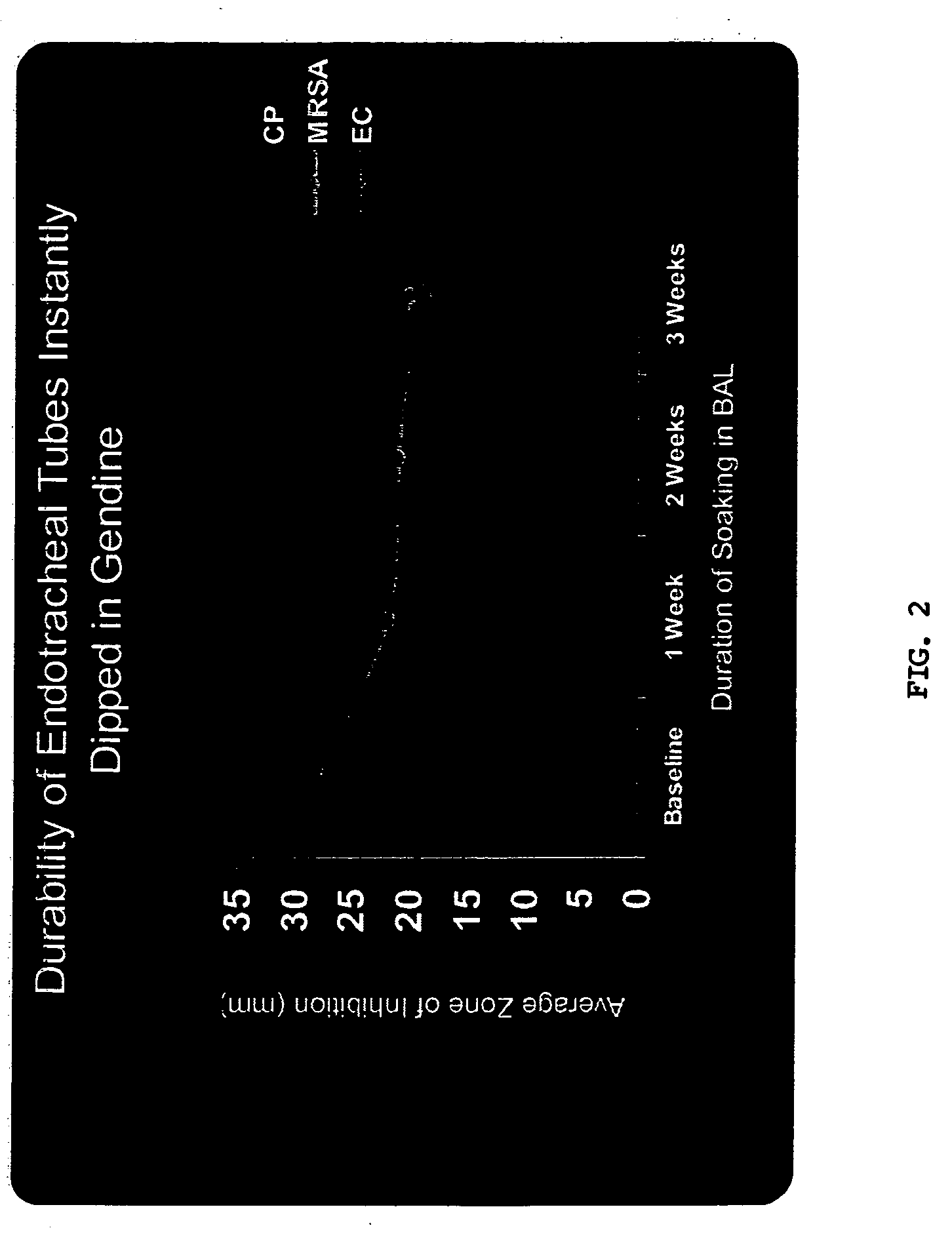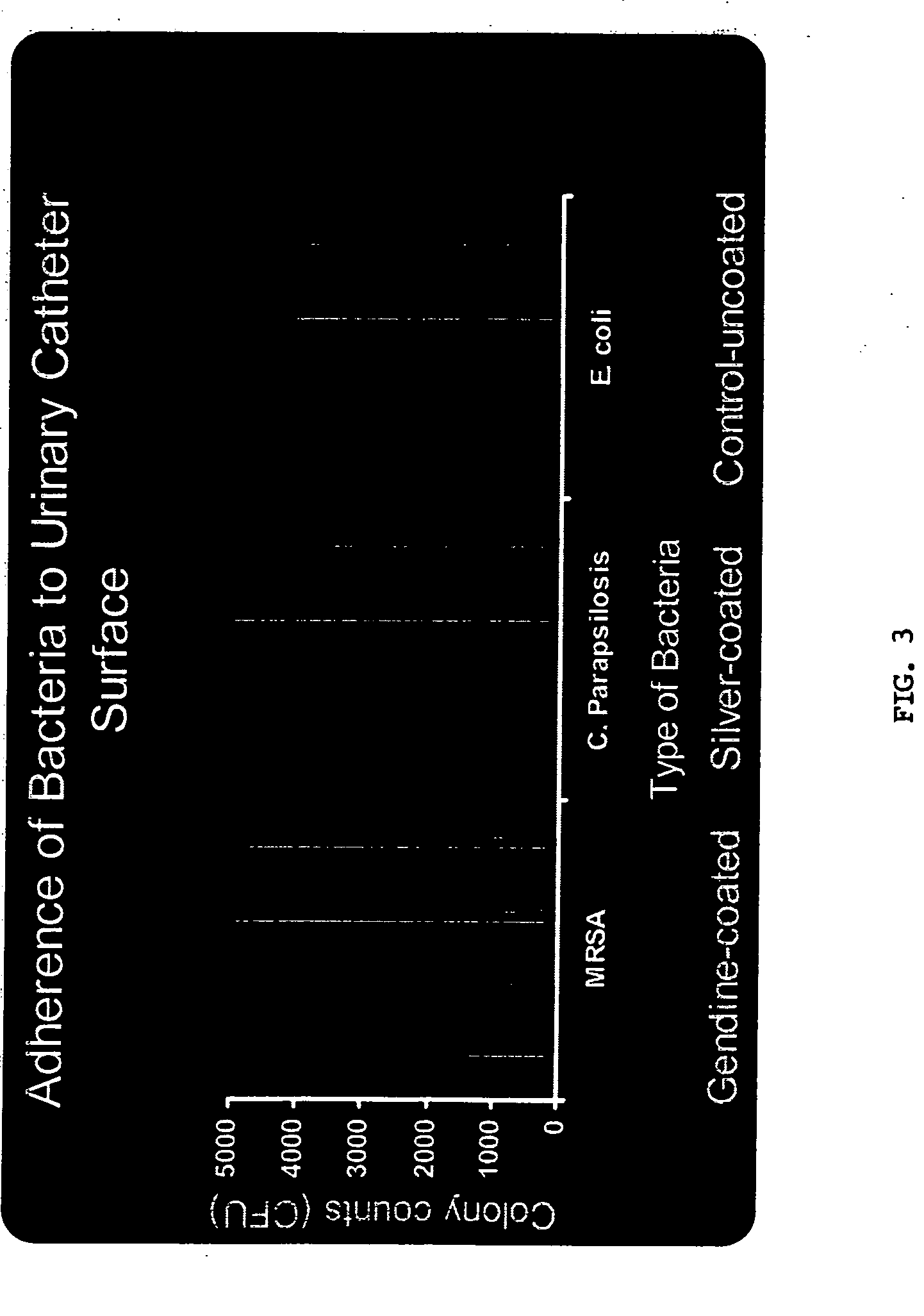Methods for coating and impregnating medical devices with antiseptic compositions
a technology of compositions and medical devices, applied in the field of microbiology, can solve the problems of increasing the risk of nosocomial pneumonia, difficult to impregnate with antiseptic or antimicrobial agents, and serious hospital-acquired infections, so as to prevent the growth of pathogens, prevent infection, and avoid the effect of destroying the device or causing the devi
- Summary
- Abstract
- Description
- Claims
- Application Information
AI Technical Summary
Benefits of technology
Problems solved by technology
Method used
Image
Examples
example 1
Synthesis of Gendine and Impregnation of Devices
[0052] Impregnation Procedure. The general procedure involves, and when applicable, prior preparation of the basic reagent (such as chlorhexidine) in anhydrous solvent, addition of the basic reagent to a solution of a dye (such as Gentian violet) in anhydrous solvent (or addition of the dye to the basic solution), stirring the resulting mixture for 30-90 minutes at ambient conditions, evaporating the solvent also under ambient conditions, and finally dissolution of the residue prior to impregnation. The following procedure illustrates impregnation with Gendine, an example for employing a basic guanidium derivative (e.g., chlorhexidine) and triarylmethane dye (e.g., Gentian violet).
[0053] Potassium tert-butoxide in THF, 7.35 ml of 1M solution, was added to a solution of CHX diacetate, 1.533 g; 2.45 mmol in 35 ml THF. The resulting heterogeneous solution was stirred for 20 minutes, then added to a solution GV, 1.0 g; 2.45 mmol, in 30 m...
example 2
Clinical Trials
[0063] The antiseptic devices of the invention pose no significant risk. Hence, preclinical studies (animal studies) may not be required. This section is concerned with the development of human treatment protocols using the antiseptic medical devices of the present invention.
[0064] The various elements of conducting a clinical trial, including patient treatment and monitoring, will be known to those of skill in the art in light of the present disclosure. The following information is being presented as a general guideline for use in establishing the use of the antiseptic medical devices.
[0065] Candidates will be patients who are seriously ill and are required to use a medical device such as those described in the sections above. The medical devices in these cases will be treated with Gendine, Genelol, Genfoctol, Genlosan or other antiseptic derivatives that can be synthesized by the methods provided herein, and the patients will be monitored for the occurrence of no...
example 3
“Instant Dip Method”
[0098] Materials and Methods. One cm segments of either ETT or UC were dipped in GND solution and immediately removed, followed by overnight drying. Segments were then washed and left to dry in a fume hood.
[0099] Anti-microbial activity of GND-ETT and GND-UC segments was assessed by modified Kirby-Bauer method. Segments were embedded in Mueller Hinton agar plates inoculated with one of the following organisms: Candida albicans (CA), vancomycin resistant enterococci (VRE), E. coli (EC), Candida parapsilosis(CP), methicillin resistant S. aureus (MRSA) or Pseudomonas aeruginosa (PS). Plates were incubated at 37° C. Zones of inhibition (ZOI) created by impregnated segments were measured in mm.
[0100] GND-ETT and GND-UC were immersed in sterile pooled bronchoalveolar lavage (BAL) or urine, respectively, and incubated at 37° C. BAL and urine were changed weekly and ZOI were determined in duplicate at weekly intervals.
[0101] Biofilm was formed on segments of GND-UC an...
PUM
| Property | Measurement | Unit |
|---|---|---|
| time | aaaaa | aaaaa |
| resistance | aaaaa | aaaaa |
| durability | aaaaa | aaaaa |
Abstract
Description
Claims
Application Information
 Login to View More
Login to View More - R&D
- Intellectual Property
- Life Sciences
- Materials
- Tech Scout
- Unparalleled Data Quality
- Higher Quality Content
- 60% Fewer Hallucinations
Browse by: Latest US Patents, China's latest patents, Technical Efficacy Thesaurus, Application Domain, Technology Topic, Popular Technical Reports.
© 2025 PatSnap. All rights reserved.Legal|Privacy policy|Modern Slavery Act Transparency Statement|Sitemap|About US| Contact US: help@patsnap.com



